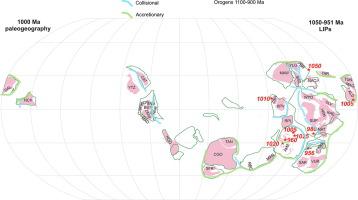Gondwana Research ( IF 6.1 ) Pub Date : 2021-05-12 , DOI: 10.1016/j.gr.2021.05.002 Kent C. Condie , Sergei A. Pisarevsky , Stephen J. Puetz

|
Of nine large age peaks in zircon and LIP time series <2300 Ma (2150, 1850, 1450, 1400, 1050, 800, 600, 250 and 100 Ma), only four are geographically widespread (1850, 1400, 800 and 250 Ma). These peaks occur both before and after the onset of the supercontinent cycle, and during both assembly and breakup phases of supercontinents. During supercontinent breakup, LIP activity is followed by ocean-basin opening in some areas, but not in other areas. This suggests that mantle plumes are not necessary for ocean-basin opening, and that LIPs should not be used to predict the timing and location of supercontinent breakups. LIP events may be produced directly by mantle plumes or indirectly from subduction regimes that have inherited mantle-cycle signatures from plume activity. A combination of variable plume event intensity and multiple plume cyclicities best explains differences in LIP age peak amplitudes and irregularities. Peaks in orogen frequency at 1850, 1050, 600 Ma, which approximately coincide with major zircon and LIP age peaks, correspond to onsets of supercontinent assembly, and age peaks at 1450, 250 and 100 Ma correspond to supercontinent stasis or breakup. Although collisional orogens are more frequent during supercontinent assemblies, accretionary orogens have no preference for either breakup or assembly phases of supercontinents. A sparsity of orogens during Rodinia assembly may be related to incomplete breakup of Nuna as well as to the fact that some continental cratons never accreted to Rodinia. There are three groups of passive margins, each group showing a decrease in duration with time: Group 1 with onsets at 2.2–2.0 Ga correspond to the breakup of Neoarchean supercratons; Group 2 with onsets at 1.5–1.2 Ga correspond to the breakup of Nuna; and Group 3 with onsets at 1.5–0.1 Ga not corresponding to any particular supercontinent breakup.
New paleogeographic reconstructions of supercontinents indicate that in the last 2 Gyr average angular plate speeds have not changed or have decreased with time, whereas the number of orogens has increased. A possible explanation for decreasing or steady plate speed is an increasing proportion of continental crust on plates as juvenile continental crust continued to be added in post-Archean accretionary orogens. Cycles of mantle events are now well established at 90 and 400 Myr. Significant age peaks in orogen frequency, average plate speed, LIPs and detrital zircons may be part of a 400-Myr mantle cycle, and major age peaks in the cycle occur near the onset of supercontinent assemblies. The 400-Myr cycle may have begun with a “big bang” at the 2700 Ma, although the LIP age spectrum suggests the cycle may go back to at least 3850 Ma. Large age peaks at 1850, 1050, 600 and 250 Ma may be related to slab avalanches from the mantle transition zone that occur in response to supercontinent breakups.
中文翻译:

LIP,造山带和超大陆:持续的传奇
锆石和LIP时间序列中的9个大年龄峰<2300 Ma(2150、1850、1450、1400、1050、800、600、250和100 Ma),只有四个分布在地理上(1850、1400、800和250 Ma) 。这些峰出现在超大陆周期开始之前和之后,以及在超大陆的组装和破坏阶段。在超大陆破裂过程中,LIP活动之后是在某些地区开放了海盆,而在其他地区则没有。这表明地幔柱对于海洋盆地的开放不是必需的,并且不应该使用LIP来预测超大陆破裂的时间和位置。LIP事件可能是由地幔柱直接产生的,也可能是间接地从俯冲机制中产生的,这些俯冲体制是从地幔柱活动中继承了地幔周期特征的。可变羽流事件强度和多个羽流循环的结合可以最好地解释LIP年龄峰值振幅和不规则性的差异。1850、1050、600 Ma的造山带频率峰值与锆石和LIP的主要年龄峰值大致重合,对应于超大陆装配的开始,而1450、250和100 Ma的年龄峰值对应于超大陆停滞或破裂。虽然碰撞造山带在超大陆组装过程中更为频繁,但增生造山带对超大陆的破裂或组装阶段没有偏爱。Rodinia大会期间造山带稀疏可能与Nuna的破碎不完全有关,也可能与某些大陆克拉通从未积聚到Rodinia的事实有关。被动边距分为三组,每组显示持续时间随时间的减少:第一组的发作在2.2–2.0 Ga处,对应于新archarean超克拉通的破裂。发病在1.5–1.2 Ga的第2组对应于努纳的分裂。第3组的发作在1.5–0.1 Ga范围内,并不对应于任何特定的超大陆破裂。
超大陆的新的古地理重建表明,在过去的2个Gyr中,平均角板速度没有随时间变化或降低,而造山带数量却增加了。板速度降低或稳定的一个可能解释是,随着陆气陆增生造山带中继续增加了幼年陆壳,板块中陆壳的比例增加。地幔活动的周期现在已经确定为90和400马币。造山带频率,平均板速,LIP和碎屑锆石的明显年龄高峰可能是400毫秒地幔周期的一部分,并且该周期中的主要年龄高峰出现在超大陆组件的开始附近。尽管LIP年龄谱显示该周期可能至少回到3850 Ma,但400 yr周期可能始于2700 Ma的“大爆炸”。


























 京公网安备 11010802027423号
京公网安备 11010802027423号